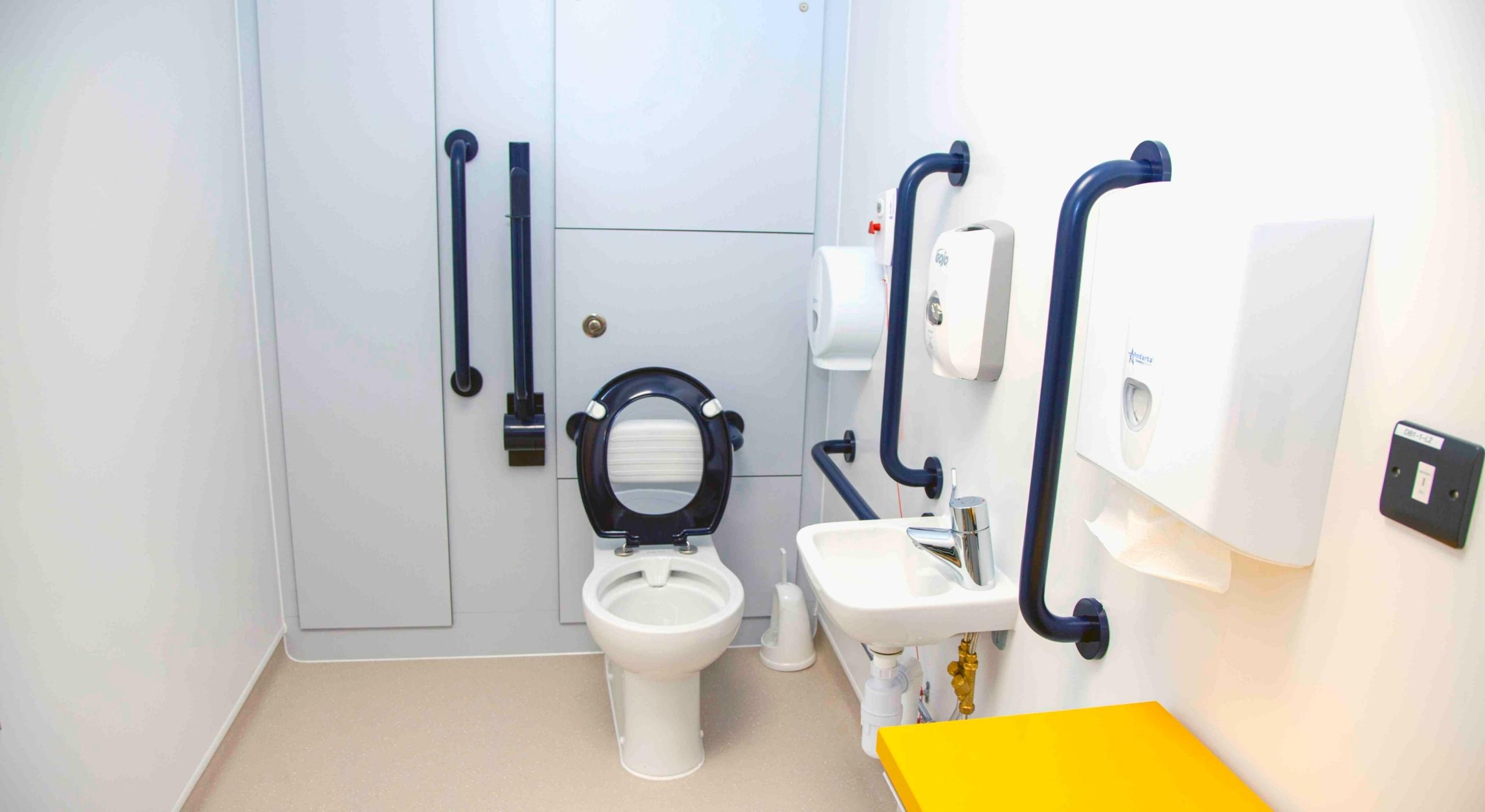Safety and Accessibility Requirements: Care Home Bathroom Requirements

Care home bathrooms are crucial spaces for residents’ well-being and independence. They require careful planning and design to ensure safety, accessibility, and comfort for individuals with varying needs.
Non-Slip Flooring
Non-slip flooring is paramount in care home bathrooms to minimize the risk of falls, a common concern for older adults.
- Tiles with a textured surface or a high coefficient of friction are ideal.
- Rubber mats or non-slip coatings can be added to smooth surfaces to enhance traction.
- Regular cleaning and maintenance are essential to maintain the effectiveness of non-slip flooring.
Grab Bars
Grab bars provide essential support and stability for residents, helping them maintain balance and prevent falls.
- Grab bars should be installed in strategic locations, such as near toilets, showers, and bathtubs.
- They should be made of durable materials like stainless steel or chrome, capable of supporting significant weight.
- Proper installation is crucial, ensuring the bars are securely anchored to the wall studs and can withstand the force applied by a user.
Accessible Bathroom Layout
Designing a bathroom with accessibility in mind is essential for wheelchair users.
- A wide doorway (at least 32 inches) allows for easy wheelchair access.
- The toilet should be positioned to provide ample space for transferring from the wheelchair.
- A roll-in shower with a low threshold eliminates the need for stepping over a barrier, making it accessible for wheelchair users.
- Grab bars should be strategically placed near the toilet, shower, and bathtub for support.
Emergency Call Systems
Emergency call systems are essential safety features in care home bathrooms.
- These systems allow residents to quickly summon assistance in case of an emergency, such as a fall or medical issue.
- Call buttons should be strategically placed within easy reach of residents, both in the shower and near the toilet.
- The system should be reliable and easy to use, with a clear signal to alert staff.
Shower and Bathing Safety
Showers and bathtubs pose a significant risk of falls, so safety considerations are essential.
- Non-slip mats or surfaces should be used to prevent slipping.
- Handheld showerheads allow residents to adjust the water temperature and direction with ease.
- Grab bars should be installed inside the shower or bathtub for stability.
- Water temperature controls should be adjustable and easy to operate.
Hygiene and Sanitation Standards

Maintaining a clean and sanitary environment in a care home bathroom is crucial for the health and well-being of residents. This section will explore key aspects of hygiene and sanitation standards, emphasizing the importance of proper ventilation, the use of antimicrobial materials, effective cleaning and disinfection procedures, and responsible waste management.
Proper Ventilation
Proper ventilation is essential for maintaining a healthy and safe bathroom environment. Adequate ventilation helps to remove moisture, odors, and airborne contaminants, reducing the risk of mold growth, bacteria proliferation, and respiratory problems.
- Exhaust Fans: Installing exhaust fans in care home bathrooms is crucial for removing moisture and odors. Fans should be powerful enough to effectively remove air from the bathroom and should be operated during and after each use. Regular maintenance of exhaust fans, including cleaning and filter replacement, is essential to ensure optimal performance.
- Windows: If available, windows can provide natural ventilation. However, windows should be strategically placed and designed to prevent drafts and ensure privacy. Regularly opening windows, especially after showers or baths, can help to remove moisture and improve air circulation.
- Ventilation System Design: When designing or renovating care home bathrooms, it’s essential to consider a well-designed ventilation system. This includes ensuring adequate airflow, appropriate fan placement, and proper ductwork to prevent backflow and contamination.
Antimicrobial Materials
Antimicrobial materials play a crucial role in preventing the spread of bacteria and germs in care home bathrooms. These materials are designed to inhibit the growth of microorganisms on surfaces, reducing the risk of infections and cross-contamination.
- Bathroom Fixtures: Antimicrobial coatings can be applied to bathroom fixtures, such as faucets, showerheads, and toilet seats. These coatings release antimicrobial agents that kill or inhibit the growth of bacteria, reducing the risk of contamination.
- Surfaces: Antimicrobial materials are also used in bathroom surfaces, including walls, floors, and countertops. These materials can be incorporated into tiles, grout, and other surface finishes, providing long-lasting protection against microbial growth.
- Benefits: Antimicrobial materials offer several benefits, including reduced risk of infections, improved hygiene, and increased durability. They are particularly important in care home bathrooms where residents may be more susceptible to infections.
Cleaning and Disinfection Procedures
Regular and thorough cleaning and disinfection procedures are essential for maintaining a hygienic bathroom environment. This involves using appropriate cleaning agents, following specific protocols, and ensuring proper disposal of contaminated materials.
- Cleaning Schedule: Establish a regular cleaning schedule for care home bathrooms, including daily, weekly, and monthly cleaning tasks. Daily cleaning should focus on high-touch areas, such as toilets, sinks, and door handles. Weekly cleaning should involve more thorough cleaning, including floors, walls, and fixtures. Monthly cleaning should include deep cleaning of hard-to-reach areas and specialized cleaning tasks.
- Cleaning Agents: Use cleaning agents specifically designed for bathroom surfaces and disinfecting agents that are effective against a broad spectrum of microorganisms. Follow the manufacturer’s instructions for dilution, application, and contact time.
- Disinfection: After cleaning, disinfect all surfaces with a disinfectant solution. Pay particular attention to areas where moisture accumulates, such as shower stalls, tubs, and sink areas. Allow the disinfectant to sit for the recommended contact time before rinsing.
- Waste Disposal: Dispose of contaminated cleaning materials and waste appropriately. Use designated waste containers for sharps and other hazardous materials. Follow all local regulations and guidelines for waste disposal.
Waste Disposal
Proper waste disposal is crucial for maintaining hygiene and sanitation in care home bathrooms. It involves using appropriate containers, following proper disposal procedures, and minimizing the risk of contamination.
- Waste Containers: Provide separate waste containers for different types of waste, such as general waste, sharps, and medical waste. Containers should be clearly labeled and easily accessible.
- Disposal Procedures: Establish clear procedures for waste disposal, including the use of gloves, proper handling of contaminated materials, and appropriate disposal methods.
- Regular Emptying: Empty waste containers regularly to prevent overflowing and odor buildup. Ensure that containers are properly cleaned and disinfected before refilling.
Hygiene and Sanitation Compliance Checklist
- Ventilation: Ensure adequate ventilation with functional exhaust fans and/or windows.
- Antimicrobial Materials: Use antimicrobial materials in fixtures and surfaces.
- Cleaning Schedule: Implement a regular cleaning schedule with daily, weekly, and monthly tasks.
- Cleaning Agents: Use appropriate cleaning agents and disinfectants.
- Disinfection Procedures: Follow proper disinfection protocols for all surfaces.
- Waste Disposal: Use appropriate containers and follow proper disposal procedures.
- Staff Training: Train staff on hygiene and sanitation practices.
- Monitoring and Review: Regularly monitor compliance and review procedures to ensure effectiveness.
Comfort and Functionality

Creating a comfortable and functional bathroom environment in a care home is crucial for residents’ well-being and independence. A thoughtfully designed bathroom can enhance their daily routines, promote dignity, and improve their overall quality of life.
Bathroom Fixtures Enhancing Comfort and Ease of Use
Choosing the right bathroom fixtures can significantly impact a resident’s comfort and ability to use the bathroom independently. Here are some examples:
- Toilets: Consider features like raised toilet seats, grab bars, and automatic flushing mechanisms to provide greater ease of use and safety.
- Sinks: Low-profile sinks with wide, accessible bowls and lever handles can be easier for residents to reach and use.
- Showers: Walk-in showers with non-slip flooring, adjustable showerheads, and handheld shower wands provide greater accessibility and control for residents with limited mobility.
Bathroom Layout Promoting Privacy and Dignity
A well-designed bathroom layout can create a sense of privacy and dignity for residents.
- Separate Spaces: Consider providing separate areas for showering, toileting, and washing to minimize potential embarrassment and maximize privacy.
- Doors: Use doors that provide a good level of privacy, and consider adding privacy screens or curtains to create a more private space.
- Storage: Provide adequate storage space for personal items, medications, and toiletries, ensuring easy access and organization.
Benefits of Adjustable Showerheads and Other Customizable Features
Adjustable showerheads and other customizable features offer significant benefits for care home residents.
- Temperature Control: Adjustable showerheads allow residents to choose the water temperature they prefer, ensuring a comfortable and safe showering experience.
- Water Pressure: Adjustable showerheads allow residents to adjust the water pressure to suit their individual needs and preferences.
- Reach and Flexibility: Handheld shower wands provide greater reach and flexibility, allowing residents to wash themselves more easily and independently.
Essential Bathroom Accessories for Care Home Residents
Providing a selection of essential bathroom accessories can greatly enhance comfort and functionality.
- Grab Bars: Strategically placed grab bars provide stability and support for residents entering and exiting the shower or bathtub, and using the toilet.
- Non-Slip Mats: Non-slip mats placed inside and outside the shower or bathtub help prevent falls and ensure safety.
- Shower Seats: Shower seats provide a safe and comfortable place to sit while showering, especially for residents with limited mobility.
- Magnifying Mirrors: Magnifying mirrors can assist residents with vision impairment in performing tasks like shaving or applying makeup.
- Toilet Paper Holders: Ensure easy access to toilet paper by placing holders within reach of the toilet.
Importance of Adequate Lighting and Temperature Control, Care home bathroom requirements
Proper lighting and temperature control in care home bathrooms are crucial for comfort, safety, and dignity.
- Lighting: Adequate lighting is essential for residents to see clearly while performing tasks such as showering, getting dressed, and using the toilet. Consider using bright, natural light whenever possible, and provide task lighting for specific areas.
- Temperature Control: Ensure the bathroom is comfortable for residents, avoiding extreme temperatures that could cause discomfort or safety hazards. Use thermostats or other temperature control mechanisms to maintain a comfortable temperature.
